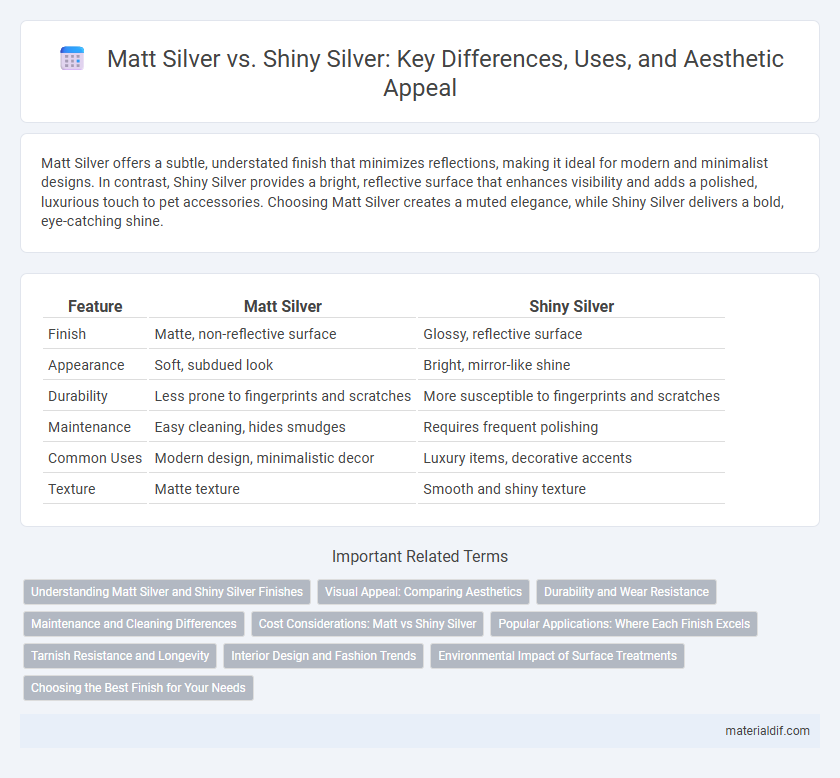Matt Silver offers a subtle, understated finish that minimizes reflections, making it ideal for modern and minimalist designs. In contrast, Shiny Silver provides a bright, reflective surface that enhances visibility and adds a polished, luxurious touch to pet accessories. Choosing Matt Silver creates a muted elegance, while Shiny Silver delivers a bold, eye-catching shine.
Table of Comparison
| Feature | Matt Silver | Shiny Silver |
|---|---|---|
| Finish | Matte, non-reflective surface | Glossy, reflective surface |
| Appearance | Soft, subdued look | Bright, mirror-like shine |
| Durability | Less prone to fingerprints and scratches | More susceptible to fingerprints and scratches |
| Maintenance | Easy cleaning, hides smudges | Requires frequent polishing |
| Common Uses | Modern design, minimalistic decor | Luxury items, decorative accents |
| Texture | Matte texture | Smooth and shiny texture |
Understanding Matt Silver and Shiny Silver Finishes
Matt silver has a soft, non-reflective surface that minimizes glare and fingerprints, making it ideal for modern, understated designs and industrial applications. Shiny silver features a highly reflective, polished finish that enhances brightness and visual appeal, commonly used in decorative items and jewelry. Understanding the differences between matt and shiny silver finishes helps in selecting the right aesthetic and functional properties for various design needs.
Visual Appeal: Comparing Aesthetics
Matt silver offers a muted, non-reflective surface that emphasizes subtle elegance and reduces glare, making it ideal for modern, minimalist designs. Shiny silver features a highly reflective, mirror-like finish that enhances brightness and creates a striking, luxurious appearance suited for decorative accents and jewelry. The choice between matt and shiny silver largely depends on desired ambiance, with matt delivering understated sophistication and shiny providing vibrant visual impact.
Durability and Wear Resistance
Matt silver features a textured, non-reflective surface that enhances its resistance to scratches and fingerprints, contributing to increased durability in everyday use. Shiny silver, characterized by its polished, reflective finish, tends to reveal scratches and wear more easily, requiring frequent maintenance to preserve its appearance. The matte finish's ability to mask minor abrasions and maintain a consistent look makes it superior in wear resistance compared to shiny silver.
Maintenance and Cleaning Differences
Matt silver finishes require gentle cleaning with a soft cloth and mild soap to avoid scratches and preserve their muted texture, while shiny silver demands more frequent polishing to maintain its reflective surface and prevent tarnishing. Maintenance of matt silver often involves less frequent but careful wiping to retain its non-glossy appearance, whereas shiny silver benefits from specialized silver polish and anti-tarnish treatments to uphold its bright luster. Both finishes need protection from harsh chemicals and abrasive materials, but shiny silver surfaces are typically more sensitive to fingerprints and smudges, requiring more consistent upkeep.
Cost Considerations: Matt vs Shiny Silver
Matt silver finishes typically cost less than shiny silver due to lower manufacturing complexity and reduced polishing requirements. Shiny silver demands additional labor and materials to achieve its reflective surface, increasing production expenses. Choosing between matt and shiny silver depends on budget constraints and desired aesthetic appeal.
Popular Applications: Where Each Finish Excels
Matt silver boasts a matte, non-reflective finish ideal for modern electronics, automotive trims, and minimalist interior designs where subtlety and reduced glare are essential. Shiny silver, with its reflective, lustrous surface, is favored in jewelry, decorative items, and luxury packaging to enhance visual appeal and highlight intricate details. Each finish excels in applications that prioritize either understated elegance or eye-catching brilliance, leveraging silver's versatile aesthetic properties.
Tarnish Resistance and Longevity
Matt silver features a brushed surface that reduces glare but is more prone to tarnishing over time compared to shiny silver. Shiny silver undergoes a polishing process that not only enhances its reflective quality but also offers better resistance to tarnish due to a smoother surface that repels oxidation. Longevity of shiny silver typically surpasses matt silver as its polished finish helps maintain appearance and delays discoloration caused by environmental factors.
Interior Design and Fashion Trends
Matt silver offers a subdued, elegant finish favored in interior design for creating minimalist and modern spaces, emphasizing texture and depth without reflective glare. Shiny silver remains popular in fashion trends, providing a bold, eye-catching metallic sheen that enhances accessories and statement pieces with a polished, futuristic appeal. Both finishes shape contemporary aesthetics by balancing subtle sophistication and vibrant allure in design and style.
Environmental Impact of Surface Treatments
Matt silver finishes reduce environmental impact by minimizing the need for harmful chemical coatings and lowering energy consumption during production compared to shiny silver options. Shiny silver surfaces often require additional polishing and plating processes involving toxic substances like chromium or nickel, increasing hazardous waste and emissions. Choosing matt silver supports sustainable manufacturing practices by promoting less resource-intensive treatments and longer-lasting surface durability.
Choosing the Best Finish for Your Needs
Matt silver offers a non-reflective, muted appearance that minimizes glare and fingerprints, making it ideal for modern, understated designs. Shiny silver provides a reflective, polished finish that enhances brightness and adds a luxurious, eye-catching element to jewelry or decor. Selecting between matt and shiny silver depends on the desired aesthetic, maintenance preferences, and the specific application's style requirements.
Matt Silver vs Shiny Silver Infographic

 materialdif.com
materialdif.com